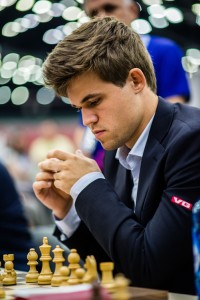King of Chess Retains Crown
December 16, 2016
On his 26th birthday, Norwegian chess grandmaster Magnus Carlsen got himself what is sure to be his favorite present this year. On November 30, in New York City, Carlsen defeated Russian challenger Sergey Karjakin to successfully defend his title as chess world champion.

Magnus Carlsen. Credit: Andreas Kontokanis (licensed under CC BY-SA 2.0)
The Fédération Internationale des Échecs (FIDE), also called the World Chess Federation, organizes the world chess championship, which takes place roughly once a year. Some famous champions from the past include Bobby Fischer, an American player who disrupted Soviet Russian dominance of the game in the 1970s; Garry Kasparov, a powerful Russian champion who famously lost to the computer Deep Blue in 1997; and Viswanathan Anand, the first Indian world champion, who lost his title to Carlsen in 2013.
In high-level chess, players are so skilled and well-prepared that they are often unable to gain a major advantage over each other during a game. Therefore, ties—called draws—are common. Also, at such a high level, the player who has the white pieces can take advantage of having the first move (white always moves first). Therefore, wins with white are somewhat more common than wins with black.
The 2016 championship match between Magnus and Karjakin started with 12 games in which each player had several hours to complete his moves. Magnus, the world champion since 2013, came into the match a heavy favorite against the challenger Karjakin, the sixth-ranked player in the world. Karjakin came well prepared, however, and the pair drew the first 7 games of the match. Carlsen held advantages several times during these games but couldn’t convert them into victories as Karjakin put up strong defenses. Karjakin unexpectedly won game 8—with the black pieces—briefly putting him in control of the match. But Carlsen recovered to win game 10, and the opponents uneventfully drew the final two regulation games.
The match then moved on to a series of fast-moving, tie-breaking games, all played on November 30. In these games, move times were limited to 25 minutes. After Karjakin managed to force draws in the first two games, Carlsen finally broke the deadlock, winning the next two and claiming the championship.
While Carlsen and Karjakin battled for the title, far stronger chess players could be found all around them in computers. Ever since Kasparov lost to Deep Blue in 1997, computer hardware and chess programs have become ever more sophisticated. Today, good chess programs running on powerful computers could likely defeat Carlsen in a match. Earlier this year, a program called AlphaGo beat the world champion of Go, a board game popular in Japan that is considered even more complex than chess. Computers have far surpassed their creators in board games, but being the greatest human player remains a magnificent accomplishment. Still a young man, Magnus Carlsen continues to build on his legacy as one of chess’s greatest ever players.


